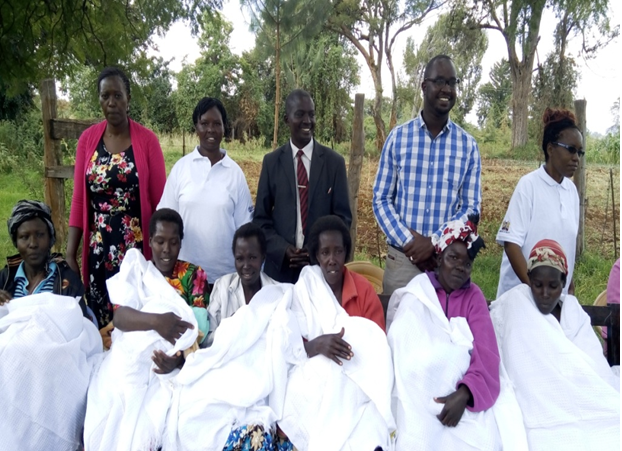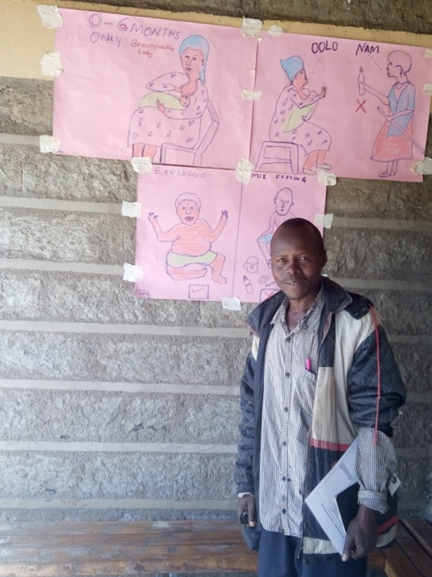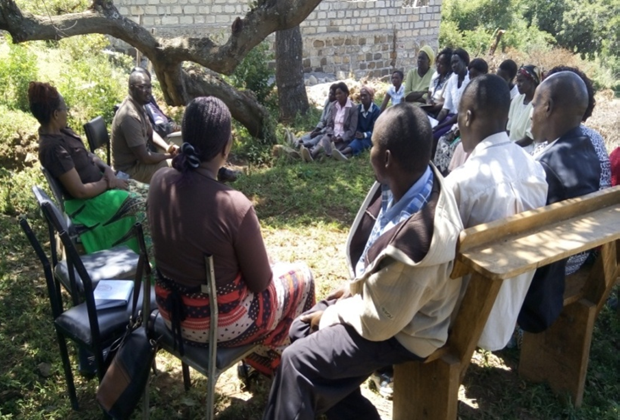Feasibility and effectiveness of the baby friendly community initiative (BFCI) in Kenya: A pilot community trial in a rural setting.Principal Investigator: Judith Kimiywe, Kenyatta University
NIH-Supported Collaborator: Stephen McGarvey, Brown University
Title of NIH Award: Diabetes Care in American Samoa
Project Dates: October 2013 - April 2017
Project Overview:
Nutrition in the first 1000 days of life is critical for child growth, wellbeing and survival. There is evidence that undernutrition is associated with more than half of child deaths due to its influence on morbidity. Interventions promoting optimal maternal infant and young child nutrition (MIYCN) could prevent a fifth of under five deaths. Poor MIYCN practices are widely documented in Kenya, like in other developing countries, with potential detrimental effects on child growth, health and survival. The Division of Nutrition (DON), Kenya, developed a national strategy to promote optimal MIYCN practices in 2007, actualized mainly through the baby-friendly hospital initiative (BFHI) in maternity wards. However, since only two in five women deliver in health facilities, majority of women lack this support and MIYCN practices are greatly influenced by traditional beliefs and practices. Hence the impact of BFHI is minimal. Recognizing the need to reach women at the community level, The DON is therefore considering implementing the Baby Friendly Community Initiative (BFCI), which employs the principles of BFHI at the community level. Hard evidence on the effectiveness of BFCI and how it works best in the Kenyan context are needed to create the political buy in, budgetary allocation and effective implementation at the national level. This study aims to pilot implementation of BFCI to determine its feasibility and effectiveness with regards to maternal and child nutrition and health status in a rural setting in Kenya. The study will be conducted in East Pokot, a semi-arid rural district with poor health access in North Rift region of Kenya. The study will combine both qualitative and quantitative methods to answer the research questions. A formative study using participatory action research will be conducted. Then, a quasiexperimental study with both qualitative and quantitative data collection will be conducted. Data on MIYCN practices, nutritional status and health of the children will be collected on cohorts of mother-child pairs in both intervention and control arms through baseline and end-line cross-sectional surveys. The study will generate sound scientific evidence on the feasibility and effectiveness of implementing BFCI on maternal, infant and young child nutrition and health outcomes. This will inform effective and efficient scale-up of the BFCI in Kenya.
Final Summary of Project Activities Overall this project was very successful. The government and development partners have adapted its methods for up scaling to other regions in Kenya and the program has attracted other regional countries who are planning to come and learn from its experiences. The team has received international interest and has been asked for information and expertise in a number of new projects that focus on MIYCN in developing countries.
Initially, the project site was designated as the East Pokot sub-county of Baringo, but due to insecurity challenges around cattle rustling coupled with other hindrances, the project team, in consultation with the Division of Nutrition and Dietetics of Ministry of Health, decided to change the study site to Koibatek within the same county. A reconnaissance and a community mobilization visit was conducted in July 2014 where the team held inception meetings with the Baringo County Health Management Team (CHMT) and Koibatek sub-County Health Management Team (ScHMT). The Ministry of Health was a key stakeholder in the implementation of the intervention and the study and fully involved in every aspect of it including the training of the CHVs, orientation of health care workers in the sub-county on the BFCI package, and supervision of the project.
Community mobilization for the project was conducted in July, 2014 with the Baringo County Koibatek health management teams. The officers were briefed on the purpose of the BFCI project and planned activities including the orientation of the sCHMT team, training of the CHVs, CHEWs and health facilities workers. The sub-county health management team briefed the project team on the structure of the community health strategy and how many community health units were in existence and their status. The project team was also briefed on other activities undertaken or were ongoing on nutrition and health within the sub-County.
A formative study was conducted in August 2014 to establish the knowledge, attitudes and practices regarding maternal nutrition, breastfeeding and complementary feeding; establish contextual and cultural factors which contribute towards maternal, infant and young child (MIYCN) practices; and inform customization of BFCI including the role of key persons involved in reproductive health such as traditional birth attendants (TBAs). Focus group discussions were conducted with women of reproductive age (15-49 years) who were either pregnant, breastfeeding or had ever breastfed and with CHVs and village elders. Key informant interviews were conducted with healthcare professionals, sub-County health management team, TBAs, the chiefs, assistant chiefs, village elders and religious leaders. This information was used to guide the structure of the implementation of the intervention and the finalization of the quantitative tools for assessing the study outcomes.
Thirteen qualitative data collectors were recruited in early August, and trained for one week. Community mobilization for the formative study took place immediately after the training and piloting of the data collection tools. The project team reached 145 community members; 8 chiefs, 18 assistant chiefs, 57 village elders, 35 religious leaders and 27 women leaders drawn from across the 13 community health units in Koibatek. The research team conducted a total of 52 interviews involving 160 respondents. These included 16 FGDs, 14 IDIs and 22 KIIs.
A stakeholder’s workshop with all relevant partners and other stakeholders including the Unit of Nutrition and Dietetics in the Ministry of Health, nutrition specialists from academic institutions, UNICEF, FAO, Save the Children, World Vision was held on October 2014 and preliminary results of the formative study disseminated, discussions were held on how to use the findings to tailor the intervention and the prospective data collection and a revised work plan for the study was developed. Dissemination, consultation, and planning meetings in Koibatek sub-County were held with the county and sub-county health management teams, stakeholders and community members in December, 2014. Formative study findings were used to inform project intervention activities, formation of community mother support groups, Income Generating Activities for CHVs.
Training/orientation of CHVs on the BFCI was done from 23 – 27 February 2015. 145 CHVs out of a possible 161 were sensitized, in addition to 13 CHEWs who supervise CHVs’ activities in the community units. Topics covered included maternal infant and young child nutrition and breastfeeding practices, keys to successful breastfeeding. Other topics were mother to child transmission, infant feeding and HIV, infant and young child nutrition practices, formation of mother support groups. A midline qualitative evaluation was conducted about halfway through the intervention with the aim of documenting experiences by the study community with the ongoing intervention. The midline study explored enablers, barriers and successes recorded thus far and recommendations for change or future practice. This was collected through in-depth interviews and focus group discussions with mothers, and focus group discussions with CHVs and village elders, and key informant interviews with chiefs, religious leaders, health care professionals, TBAs and the sub-county Health Management Team members.
Midline qualitative evaluation was conducted in early February 2016. The team trained conducted 68 interviews involving 163 participants. These included 19 FGDs, 29 IDIs and 20 KIIs. Key informants included the sub-County Medical Officer of Health (sCMOH), sub-County Nutrition Officer (sCNO), and sub-County Community Strategy Coordinator (sCCSC), Health Care Workers (HCWs) from the intervention units and all the Community Health Extension Workers (CHEWs) from all the 13 units. IDIs were conducted with pregnant women below 25 years and above 25 years, lactating women below 25 years and above 25 years, and a Community Health Committee representative. The FGDs comprised of Community Health Volunteers from all the units and spouses and grandmothers in the intervention units.
Endline qualitative assessment was conducted in February 2017 to document experiences by the study community and other stakeholders regarding the BFCI including challenges and opportunities encountered. Evaluation sought information on recommendations for change/future practice for similar interventions.
Interviews with mothers covered their experience with the intervention, lessons learned, challenges, benefits, opportunities and recommendations for change. FGDs with CHVs covered experiences in delivering the intervention, facilitating, limiting factors and recommendations for change. KIIs with CHC representatives, health care workers and the sCHMT covered experiences with delivering the intervention, perceived and observed benefits accruing to the community, lessons learned, challenges, opportunities and recommendations for change. A total of 42 interviews were conducted on 84 participants.
The project team participated in its own and other government initiated workshops between January and March 2015, convened to finalize on the review of tools for monitoring and evaluation of the BFCI intervention. The monitoring tools administered to healthcare workers and CHVs to assess the compliance of the health facilities in the intervention units to BFCI. A workshop to finalize on the tools was held in April 2015.
Recruitment of study participants was completed in May 2016 with a total of 901 participants enrolled into the study while household data collection on mother and child pairs was completed in December 2016. 78 of the recruited mother-child pairs had been lost to follow up for reasons that included death of either the mother or child, outmigration from study area, cross migration from intervention unit to control unit and vice versa and termination of pregnancy among others.
The project team conducted dissemination meetings of the study findings and outcomes at the community, sub-county and county levels in April, 2017 and at the national level in May 2017.
Publications
Kimani-Murage, E.W., Kimiywe, J., Kabue, M. et al. Feasibility and effectiveness of the baby friendly community initiative in rural Kenya: study protocol for a randomized controlled trial. Trials 16, 431 (2015).
https://doi.org/10.1186/s13063-015-0935-3Health Cycle 1 Recipients






